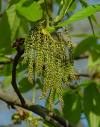Bullnut Tree Information
Images of Bullnut:






Bullnut grows in the following 29 states and provinces:
Alabama, Arkansas, Connecticut, Delaware, Florida, Georgia, Illinois, Indiana, Iowa, Kansas, Kentucky, Louisiana, Maryland, Massachusetts, Michigan, Mississippi, Missouri, New Jersey, New York, North Carolina, Ohio, Oklahoma, Pennsylvania, Rhode Island, South Carolina, Tennessee, Texas, Virginia, West VirginiaInformation about Bullnut:
The Carya Tomentosa is commonly known as the Bullnut, Hognut, Mockernut, Mockernut Hickory, White Hickory as well as Whiteheart Hickory.
The currently accepted scientific name for mockernut hickory is Carya tomentosa Nutt. . Recognized morphological varieties based on differences in the leaves and fruit include : Var. subcoriacea (Sarg.) Palm. & Steyermark, commonly known as Gulf mockernut hickory, it is distiguished from the typical variety by having thicker, more pubescent leaves, and a fruit more prominently angled with thicker and larger nuts. Var. ficoides Sarg., commonly known as fig mockernut hickory, is distinguished from the typical variety by having a stipelike base to the fruit. Var. ovoidea Sarg., commmonly known as ovoid mockernut hickory, is distinguished from the typical variety by having a long-acuminate ovoid fruit. Mockernut hickory hybrid products are : C. tomentosa x C. illinoensis = C. X schneckii Sarg. C. tomentosa x C. ovata = C. X collina LaughlinMockernut hickory grows from Massachusetts and New York west to southern Ontario, southern Michigan, northern Illinois, southeastern Iowa, Missouri, and eastern Kansas; south to eastern Texas; and east to northern Florida. Mockernut hickory is most abundant southward through Virginia, North Carolina, and Florida. It is also abundant in the lower Mississippi Valley and grows largest in the lower Ohio River Basin .Some of the information provided here is attributed to:Coladonato, Milo. 1992. Carya tomentosa In: Fire Effects Information System, [Online]. U.S. Department of Agriculture, Forest Service, Rocky Mountain Research Station, Fire Sciences Laboratory (Producer). , available at the USDA Fire Effects Information System (FEIS) website